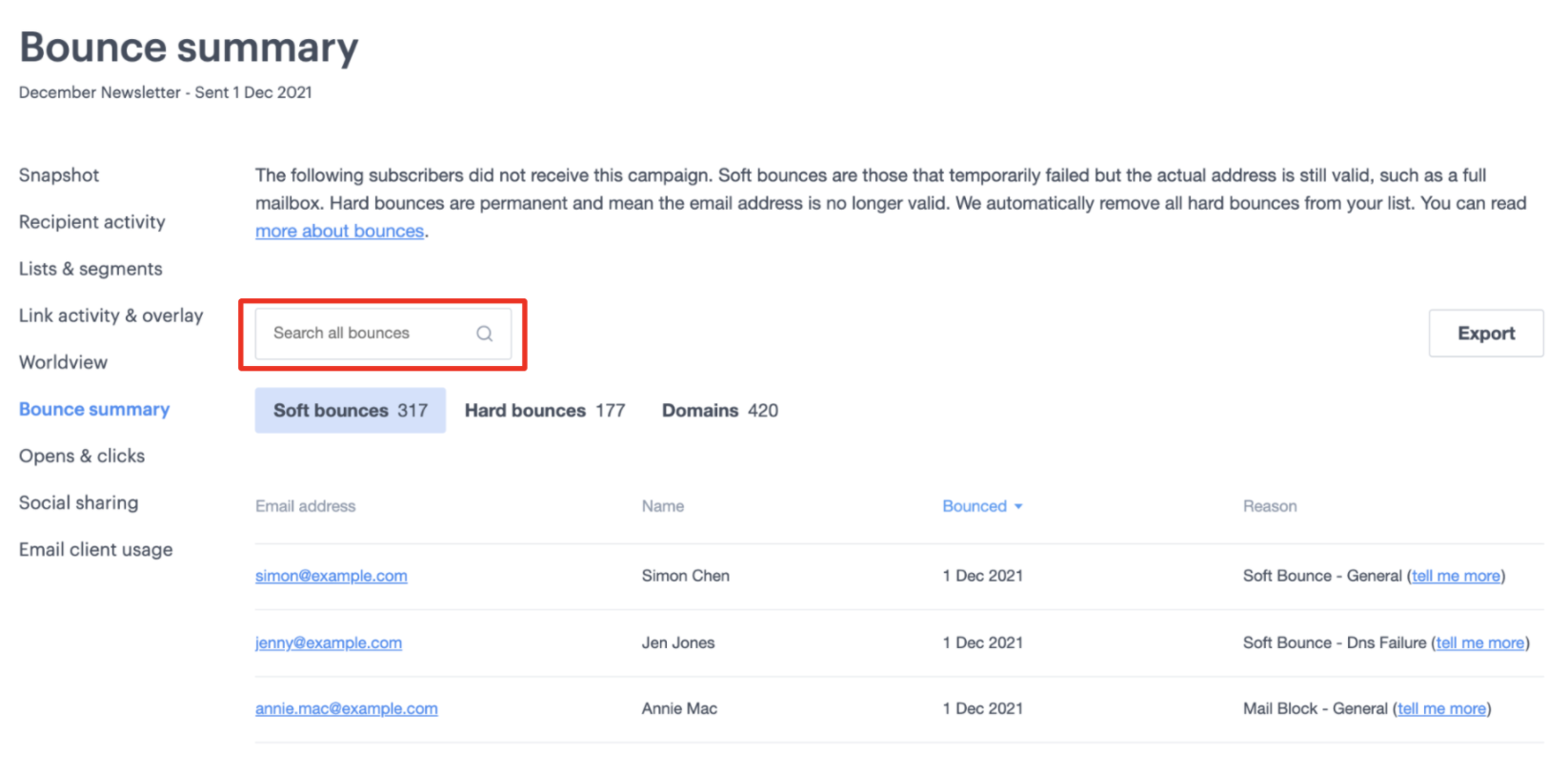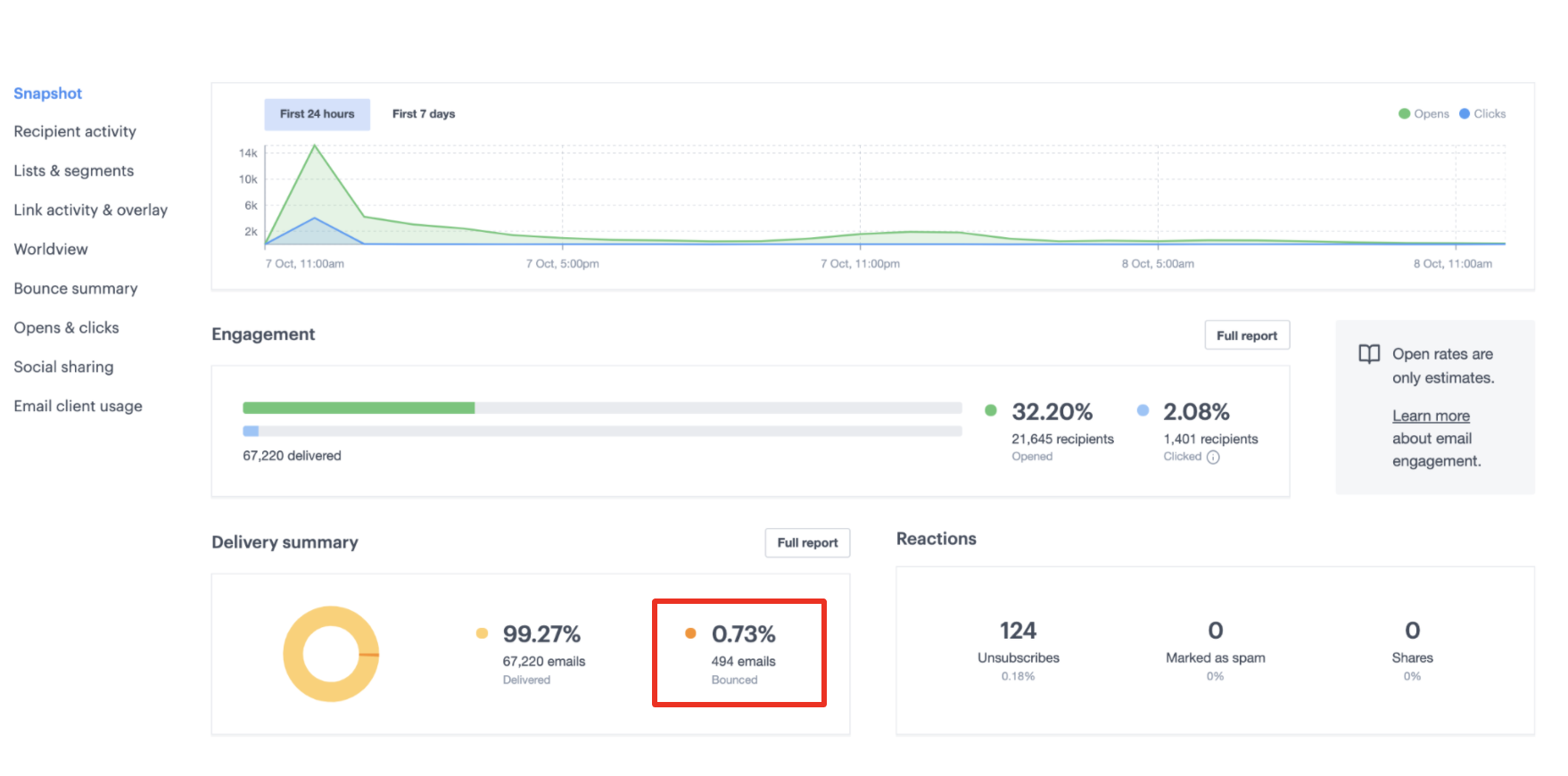When an email message cannot be delivered to an email address, it's called a bounce. There are lots of different reasons why emails bounce so, when it happens, a "return to sender" message (or, SMTP reply) is sent from the recipient's mail server to explain why.
We process bounce replies and include them in the "Bounce Summary" section of your reports. Below, we'll give you an overview of the report and explain how we handle bounced email addresses.
The bounced emails report is available for campaigns and journeys.
Bounce summary report
The bounce summary report lists any email addresses that bounced, and the reason why. The error message returned is used to classify each email address as a soft or hard bounce, meaning a temporary or permanent delivery failure.
To view the bounce summary for a sent email campaign:
- Click Campaigns, then click on the relevant campaign in the "Sent" category.
- On the campaign report, click Bounce Summary in the left sidebar.
Reports for journey emails also include a bounce summary. You can access this by selecting the email in the journey designer and clicking View full report. You can only access this report once emails from this journey have started to send.
On the Bounce Summary page you can search bounces by recipient name or email address.

Bounce domains
The Domains tab (pictured above) shows you how many emails bounced for each domain you've sent to. This is useful for determining if you have delivery problems with any specific domains. If you notice a large number of bounces for one domain, it may indicate that your emails are being blocked by the ISP's receiving server.
ISPs and other mail systems check incoming mail from each source and can see if you're sending to a lot of addresses that are bouncing. If they detect you are, they'll start rejecting your emails on the assumption your list is made up of automatically generated or purchased email addresses. In other words, they may be blocking you on the assumption you're a spammer.
That said, if you find that almost all of your emails to a certain domain like @gmail.com or @aol.com are resulting in bounces, it may be because your content has been identified as spammy. In these cases, your best bet is to contact support so we can look at the kind of bounces you're receiving and investigate further.
Ideal bounce rates
One of the most important metrics to monitor after you've sent a campaign is the "bounce rate", which is the number of bounced emails divided by the total number of recipients the campaign was delivered to.
A bounce rate percentage is calculated for every campaign you send and displayed on the snapshot page of your campaign report, as shown here:

It can take up to 14 hours for all bounced email addresses to appear in your report.
Bounce rates are directly related to the quality of your subscriber list. Low bounce rates are a sign of a healthy, permission-based list with active and engaged subscribers. High bounce rates indicate that there may be problems with the way your list was grown, or how it is being managed.
A healthy opt-in list should be seeing bounce rates of between 2-3%. If you are regularly generating higher bounce rates, it's important that you work out why and take action to reduce the number of bounces.
We can help you investigate the cause of high bounce rates and work out how to fix the problem, so please do contact us. If your bounce rates are regularly exceeding the industry standard of 2%, it may result in your account being suspended in which case we'll have to get in touch with you anyway.
Soft versus hard bounces
When an email bounces it is classified as either a soft bounce or a hard bounce.
Soft bounces
A soft bounce is a temporary delivery failure.
Your email campaign got as far as the receiving mail server, meaning the email address was recognized, but the message bounced back undelivered instead of reaching the recipient's inbox.
Soft bounces can occur when the recipient's mailbox is full; the receiving server is down or swamped with messages; the message size is too large; the recipient's settings do not allow for email from the sender; suspicious or spammy content has been detected, and many more reasons.
It does not necessarily mean the email address is invalid or no longer active, so while we have stopped trying to deliver your last campaign, we will try to send the next one to these addresses.
Servers can sometimes interpret bounces differently, meaning a soft bounce on one server may be classified as a hard bounce on another.
Hard bounces
A hard bounce is a permanent delivery failure.
When you get a hard bounce it means the recipient's email address is invalid or no longer in use. Typically the domain name (the bit after the @) no longer exists or it no longer has registered mail servers. But it could also be invalid due to typos, for example gnail instead of gmail.
Email addresses that hard bounce are automatically removed from your subscriber list so you don't pay to send to them again. We also add them to your suppression list which prevents the addresses from being accidentally re-imported.
Moving hard bounced subscribers back to active status negatively affects your deliverability. ISPs and spam filtering systems record instances of emails returned to senders and judge all future emails from the sender much more harshly if an invalid address is emailed again.
How we handle bounces
We work hard to keep bounces as low as possible so we can deliver as many of your emails as possible. We constantly monitor the email acceptance rates of our outgoing IP addresses and use sophisticated algorithms to automatically adjust sending rates, as well as which sending IPs are used.
As mentioned earlier, when an email address appears in the Bounce Summary report it means we are no longer attempting to deliver your campaign to that email address. However, unless it's a hard bounce, we do make repeated attempts to deliver the email.
When we determine that a recipient ISP appears to have temporary delivery issues we'll try resending after five minutes, and then (approximately) after every 15 minutes. We do not try for more than 14 hours to deliver a campaign because this ends up burying deliverability issues instead of alerting you to them.
When a soft bounce becomes a hard bounce
When an email address returns a soft bounce 5 times, with no opens or clicks recorded during that period, we automatically convert that address to a hard bounce.
When a subscriber interacts with an email, the number of soft bounces recorded for that address (if any) is reset to zero.
Frequently asked questions
Below are some answers to questions we're commonly asked about bounced emails. If you have a question we haven't addressed please contact us.
How long does it take for bounced emails to appear in campaign reports?
In most cases, email addresses that have bounced will show up in your report within a few minutes of the campaign being sent.
Email addresses that have hard bounced typically appear first because a hard bounce is a permanent delivery failure. With soft bounces, which are temporary delivery failures, it can take up to 14 hours for them to appear in your report because that's how long we keep trying to deliver the message.
Does a bounce mean my email has landed in the recipient's junk folder?
No. Bounced emails don't make it as far as the junk or spam folder. If your email was sent to a recipient's junk folder, their email address would not appear in the bounce summary report, and we do not receive notifications when that happens.
I have an email address listed as a hard bounce, but I'm sure it's valid. What happened?
It may be that the recipient's mail server sent us incorrect information about the status of their email address. Please contact us before trying to send another email to that address so we can investigate.
Some recipients didn't receive my email, but their email address is not listed as bounced. What happened?
In most cases, it will be due to one of these reasons:
- The recipient's ISP is using a content filter and has determined that your email exceeds their "might be spam" threshold. Some ISPs are stricter than others.
- Our system has been temporarily blocklisted by the recipient's ISP. Like all commercial email service providers, this can occur. Getting your email delivered is our number one concern, so if that is the case, rest assured we're working on being removed from the blocklist as soon as possible.
- The recipient has tight spam controls applied to the email client they're using. For example, it may be set to block all email from unknown senders. If this is the case, your email might have landed in the recipient's spam or junk folder.
If an email address is not in the bounce summary report, can I assume it was delivered successfully?
Unfortunately, no. An email address can bounce but not show up in our bounce report if the receiving ISP or corporate mail administrator does not return an error message to us to report non-delivery.
It's pretty rare for this to happen but, when it does, unfortunately we have no way to confirm what happened after the email was sent from our system. This is just an unavoidable part of how email works.



